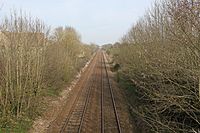Bruton railway cutting facts for kids
| Site of Special Scientific Interest | |
 |
|
| Area of Search | Somerset |
|---|---|
| Coordinates | 51°06′42″N 2°26′49″W / 51.11164°N 2.44707°W |
| Interest | Geological |
| Area | 1.7 hectares (0.017 km2; 0.0066 sq mi) |
| Notification | 1971 |
Bruton Railway Cutting is a special place in Somerset, England. It's known as a Site of Special Scientific Interest (SSSI) because of its amazing geology. This means it's a protected area where scientists can study very old rocks and learn about Earth's past. The cutting covers about 1.7 hectares, which is roughly the size of two football fields. It was officially recognized as an SSSI in 1971.
Contents
What is Bruton Railway Cutting?
Bruton Railway Cutting is a section of land that was dug out to make way for a railway line. This particular cutting is near Bruton railway station, which first opened in 1856. When the railway was built, it cut through layers of rock, revealing a fantastic display of Earth's history.
A Window into Ancient Times
The rocks you can see at Bruton Railway Cutting are incredibly old. They come from a time called the Middle Jurassic period, specifically an epoch known as the Bathonian. This was about 168 to 166 million years ago, long before humans existed! During the Middle Jurassic, dinosaurs roamed the land, and ancient seas covered much of what is now England.
What are Fossils and Ammonites?
One of the most exciting things about this site is the fossils found there. Fossils are the preserved remains or traces of ancient life. At Bruton Railway Cutting, you can find many fossils of sea creatures called ammonites. Ammonites were like ancient squid that lived inside a coiled, spiral shell. They swam in the oceans during the time of the dinosaurs.
Scientists love ammonites because different types lived at different times. This means that by studying the specific kinds of ammonites found in a rock layer, scientists can figure out exactly how old that rock layer is.
Reading the Rocks: Geological Zones
Bruton Railway Cutting is especially important because it clearly shows different "zones" of rock based on the ammonites found in them. These zones are called the subcontractus zone and the morrisi zone.
Imagine the layers of rock as pages in a giant history book. Each page (or rock layer) tells a story about a specific time period. The different ammonite zones help scientists read these pages and understand how life and the environment changed over millions of years. This cutting is considered one of the best places in England to see these different zones clearly.

